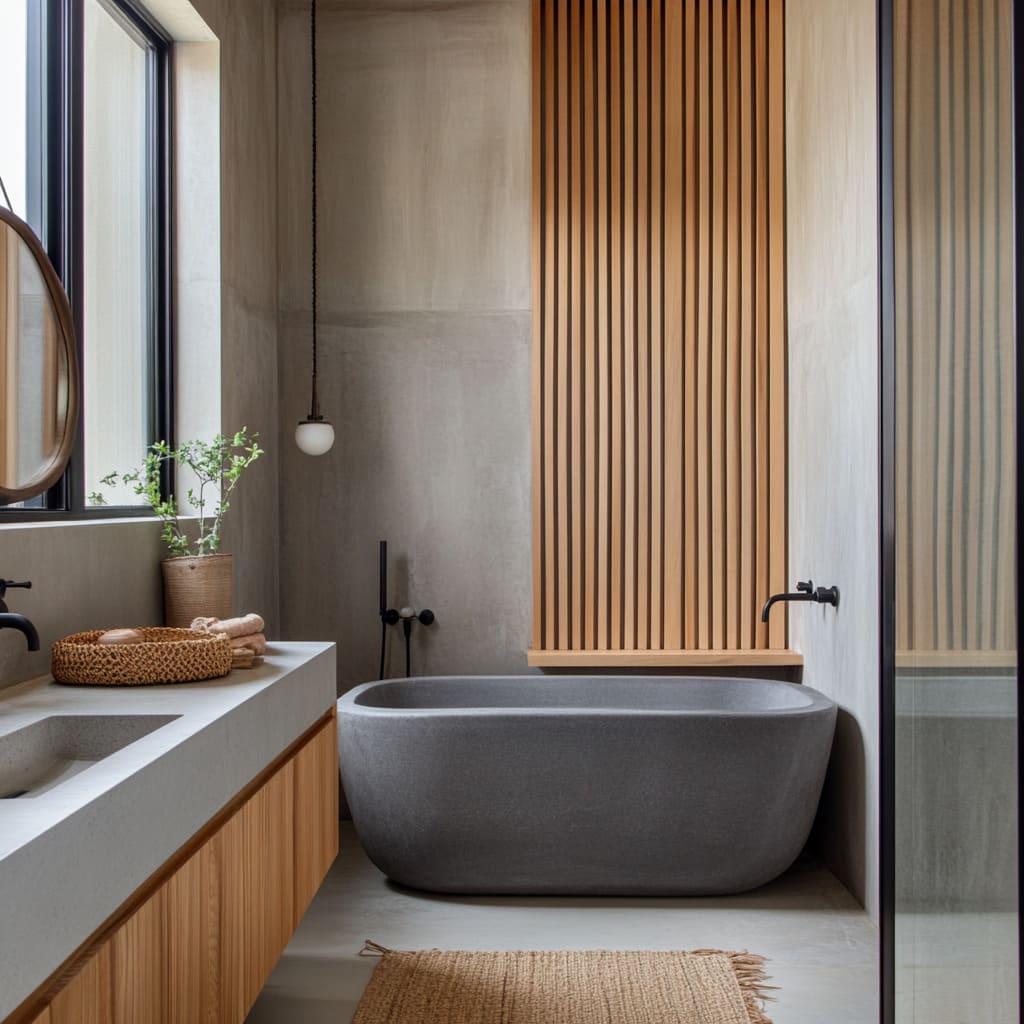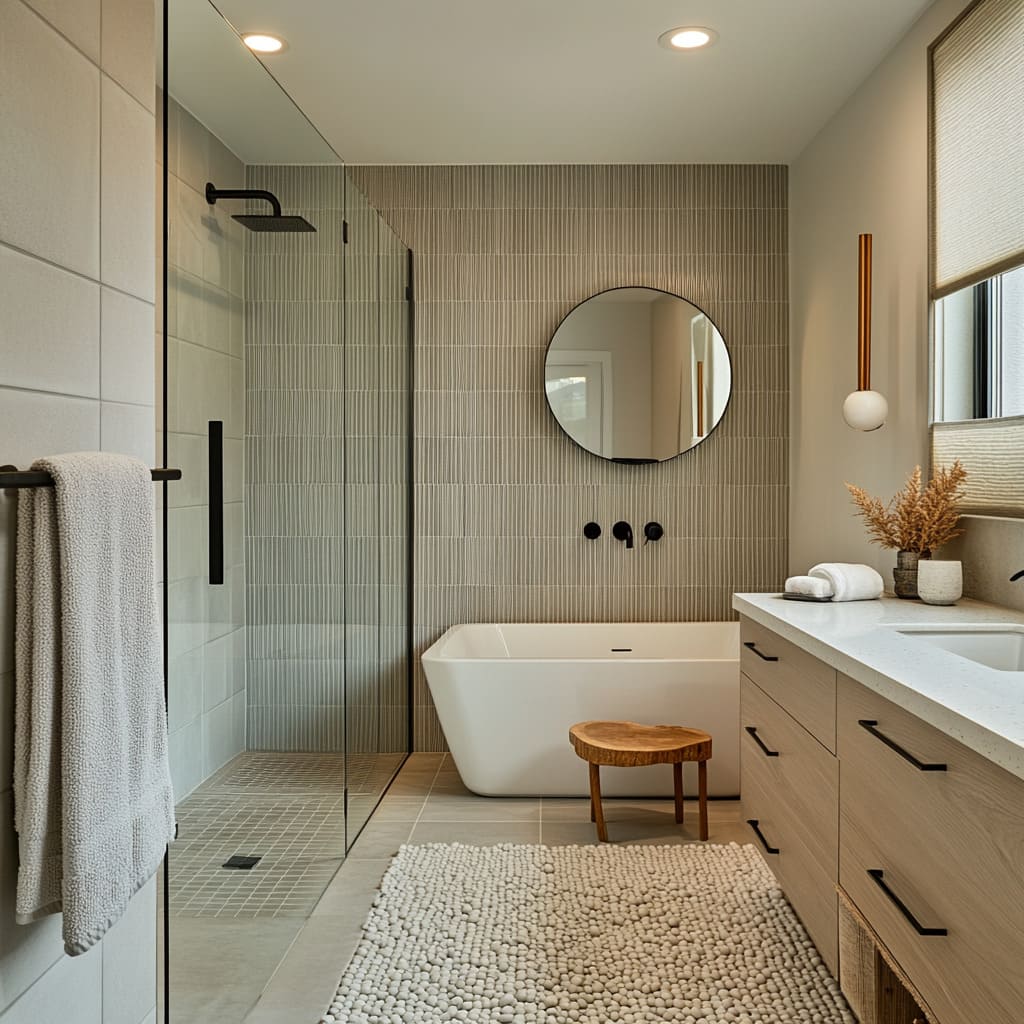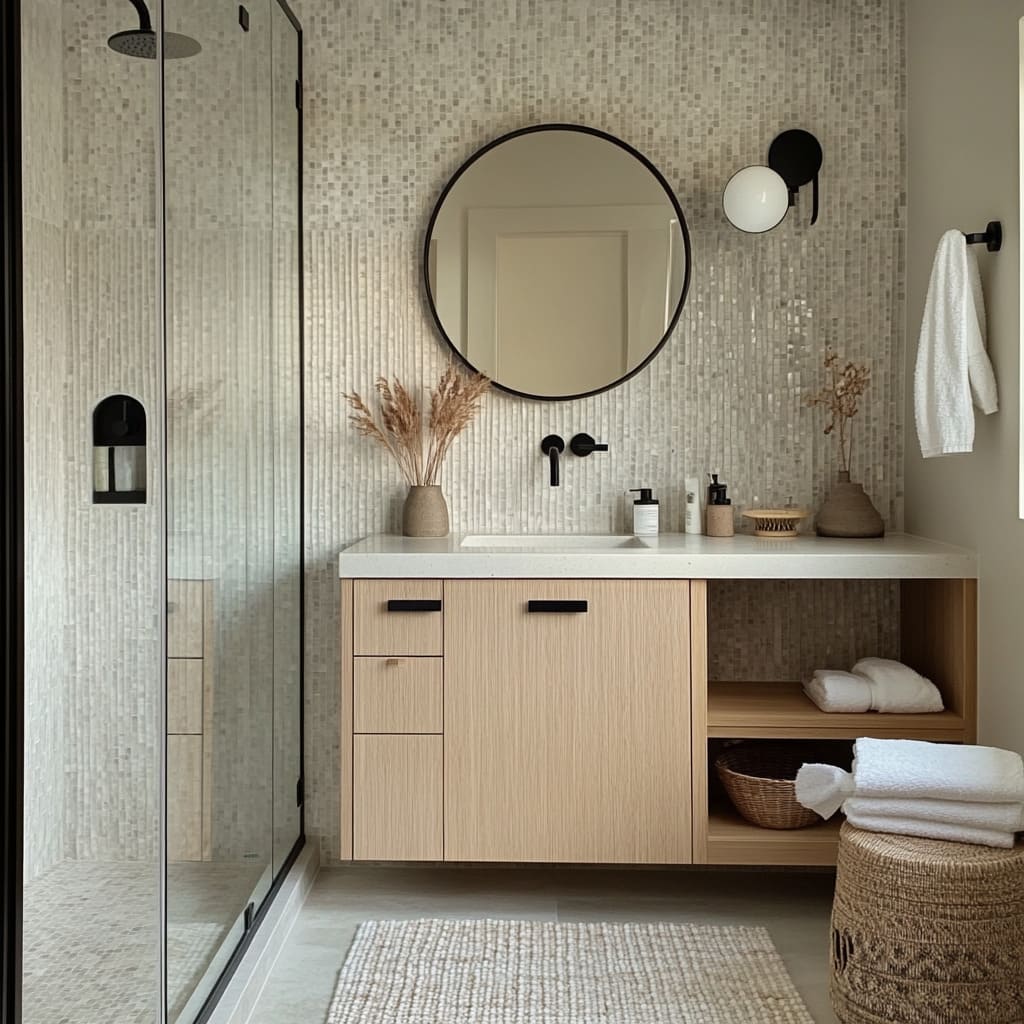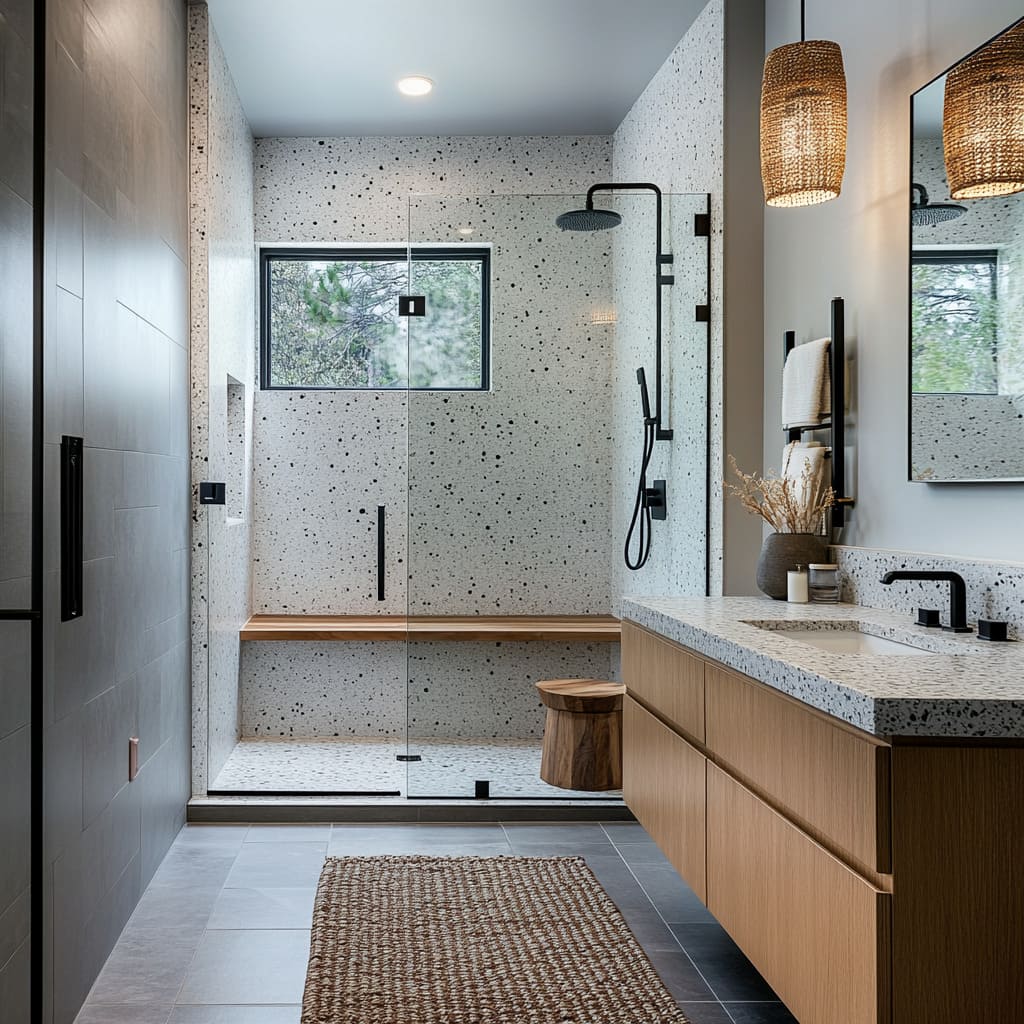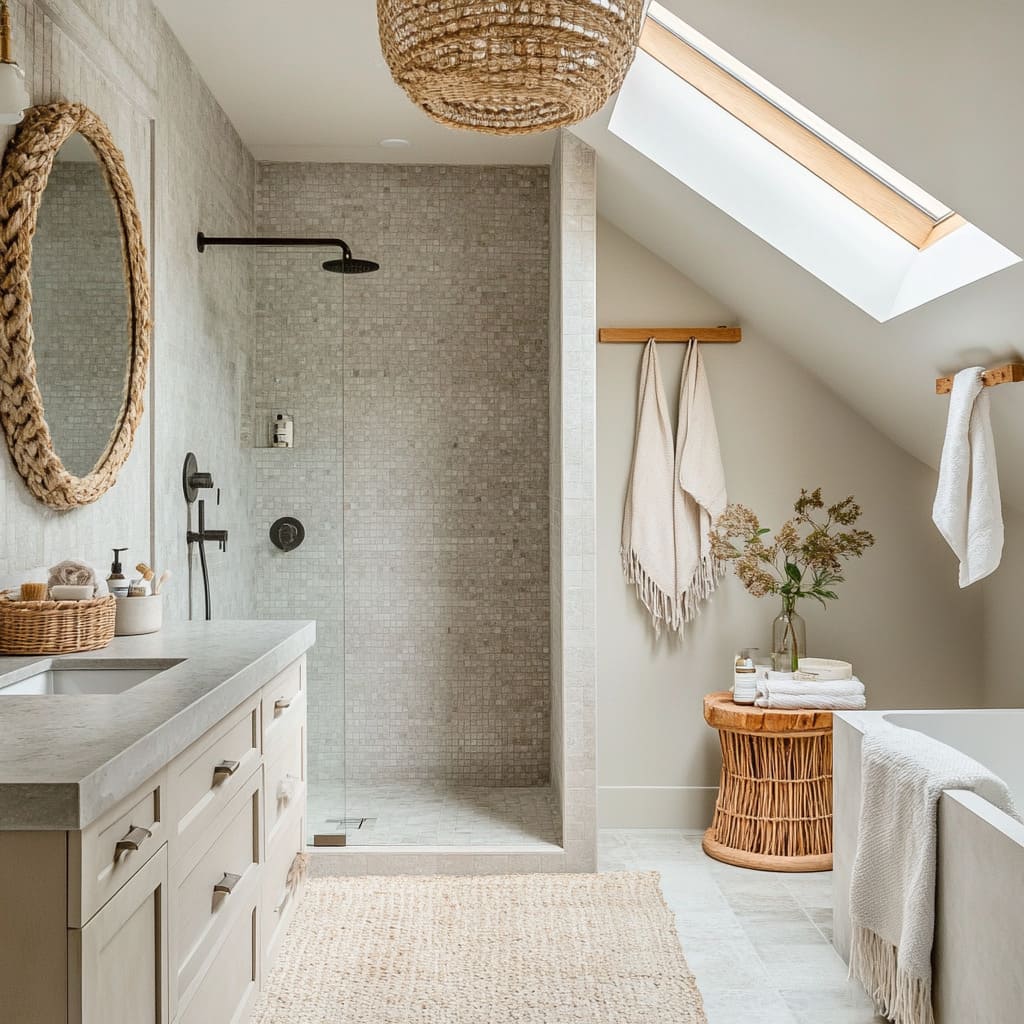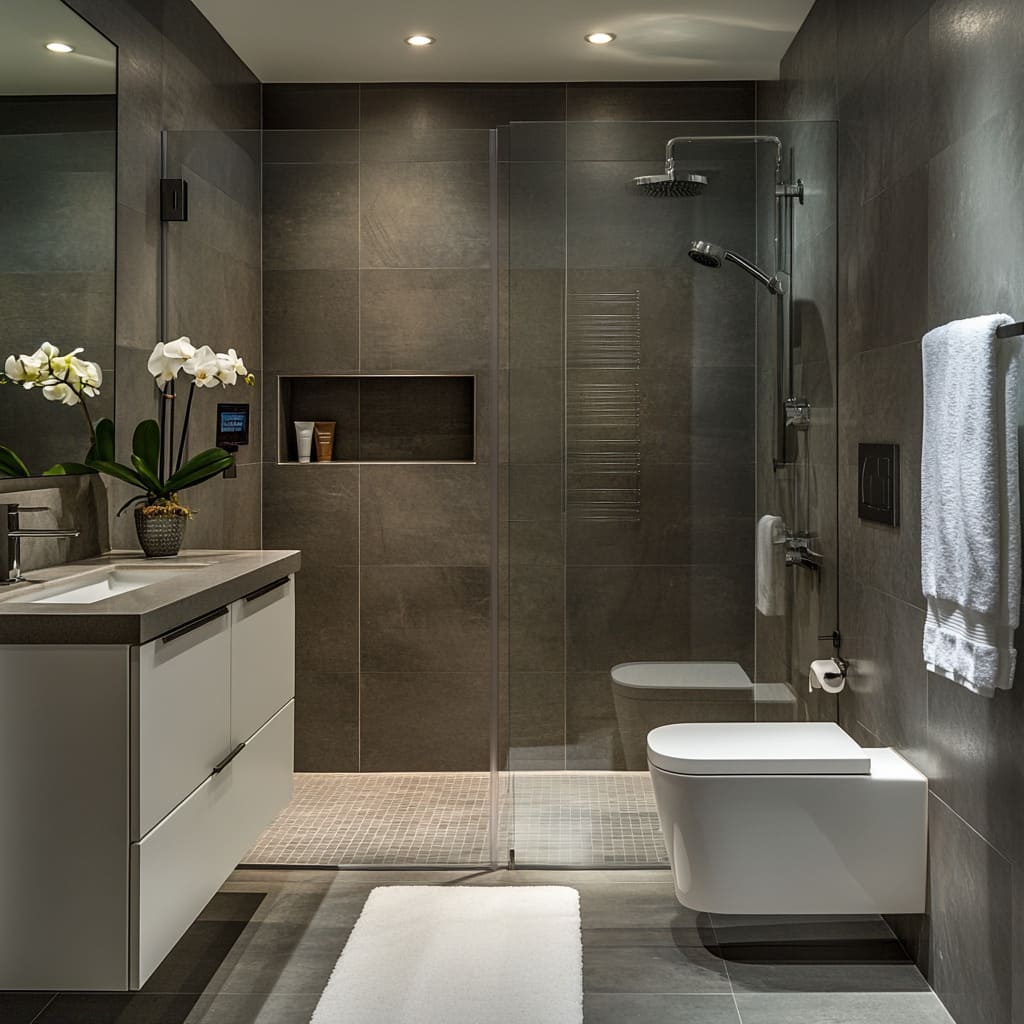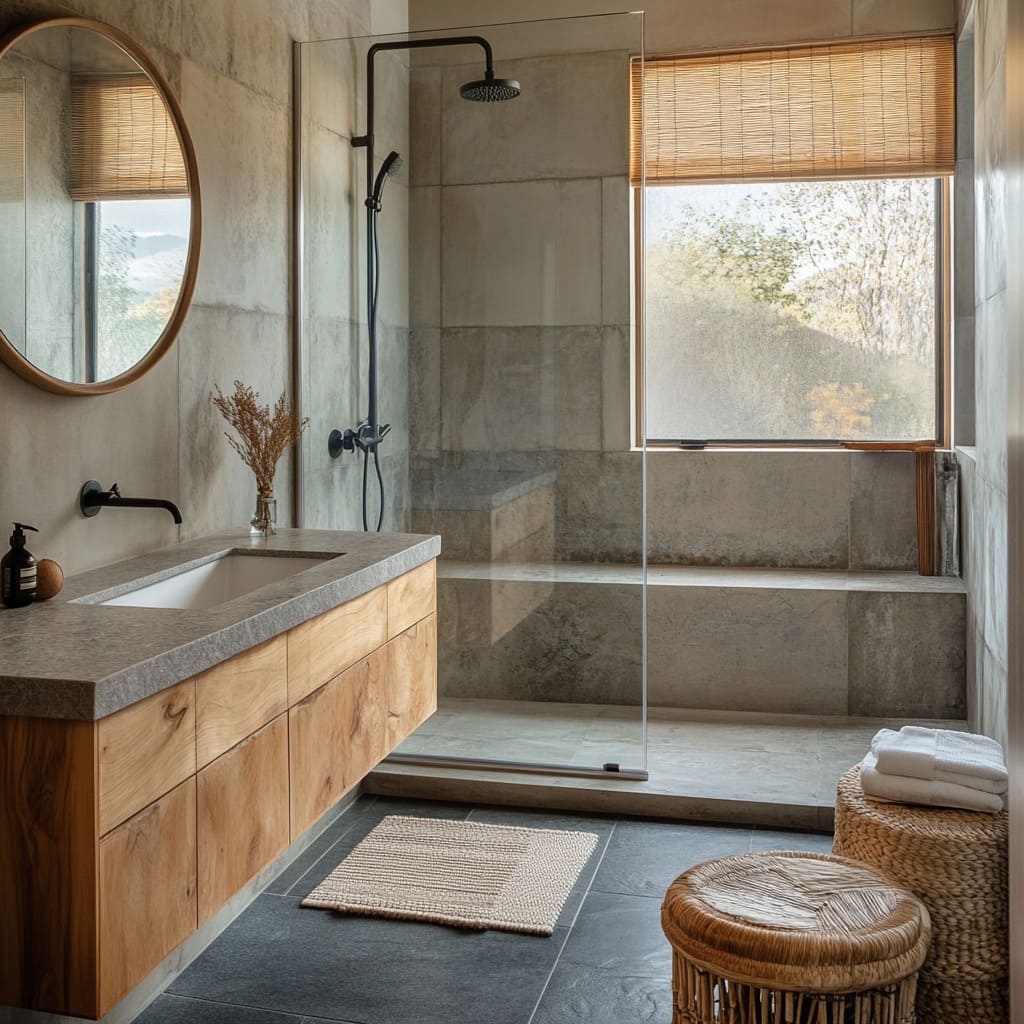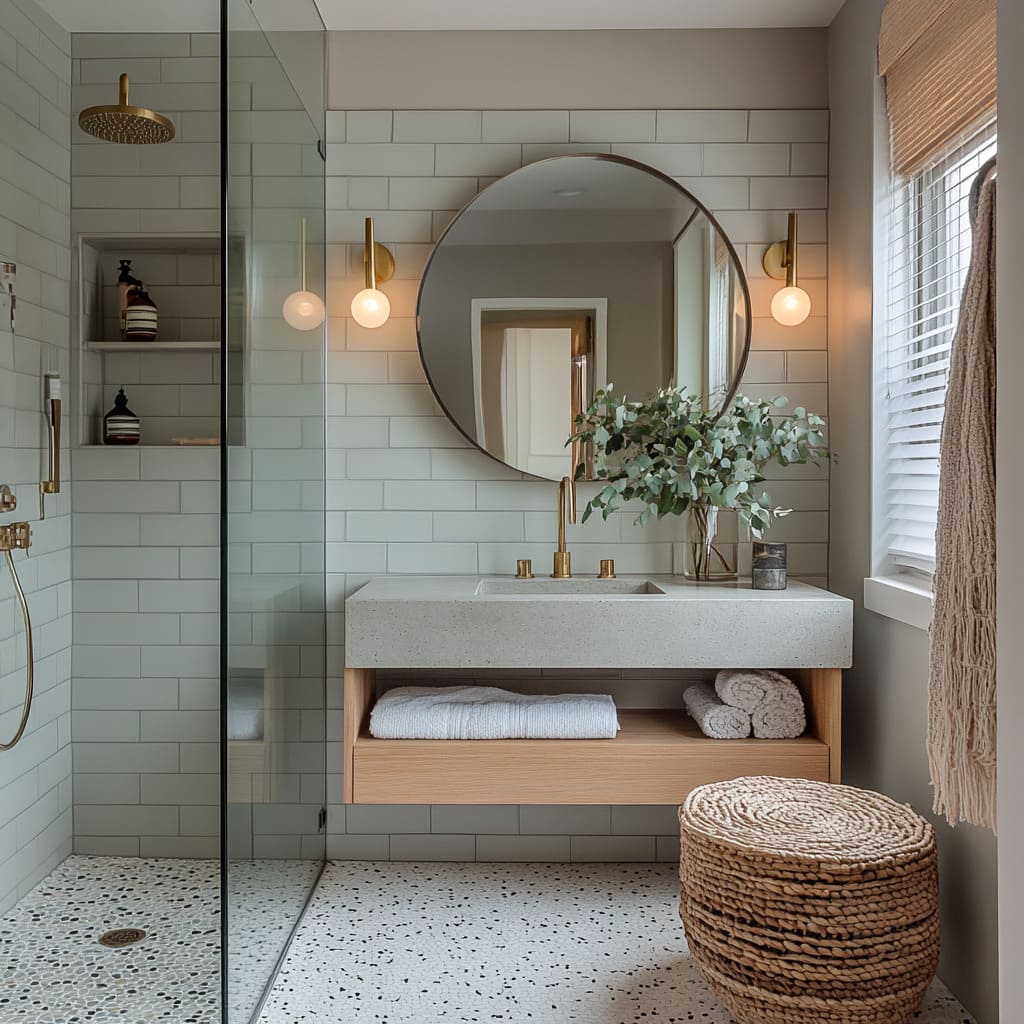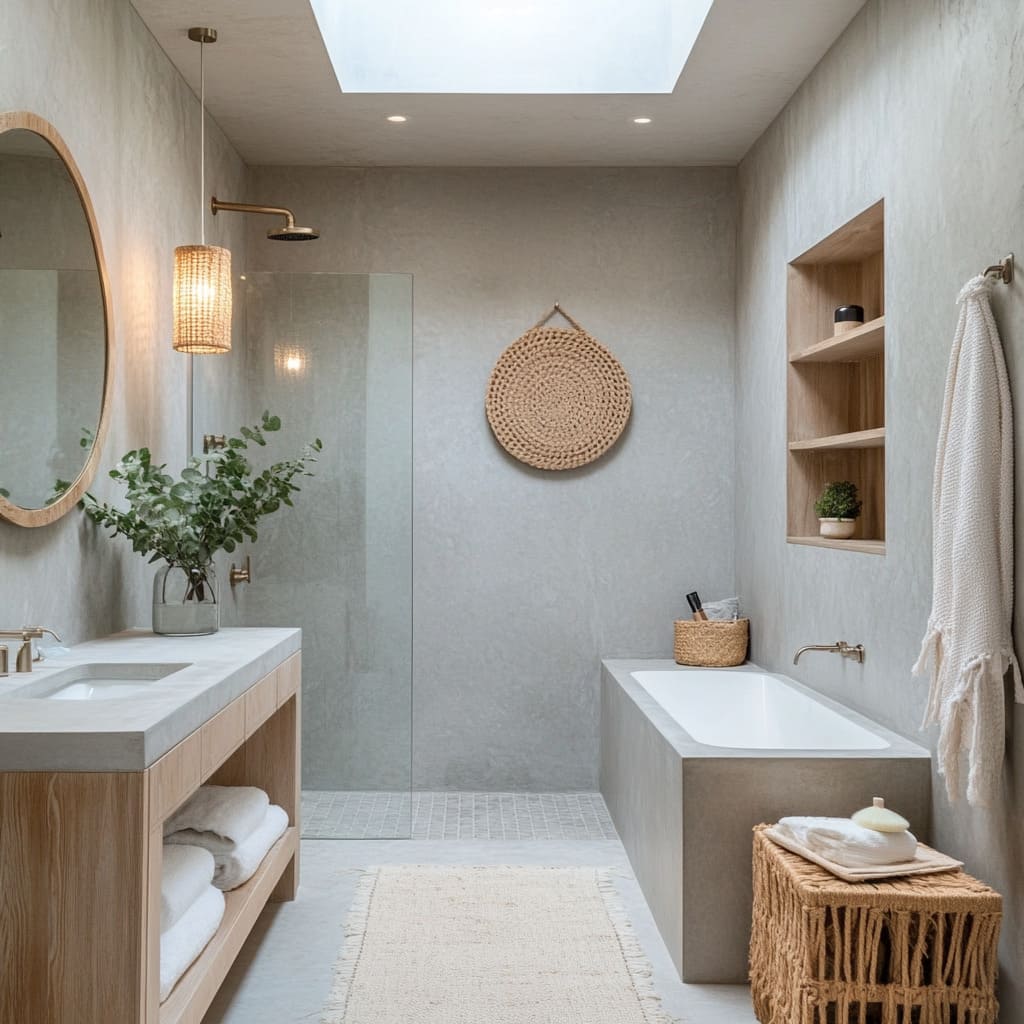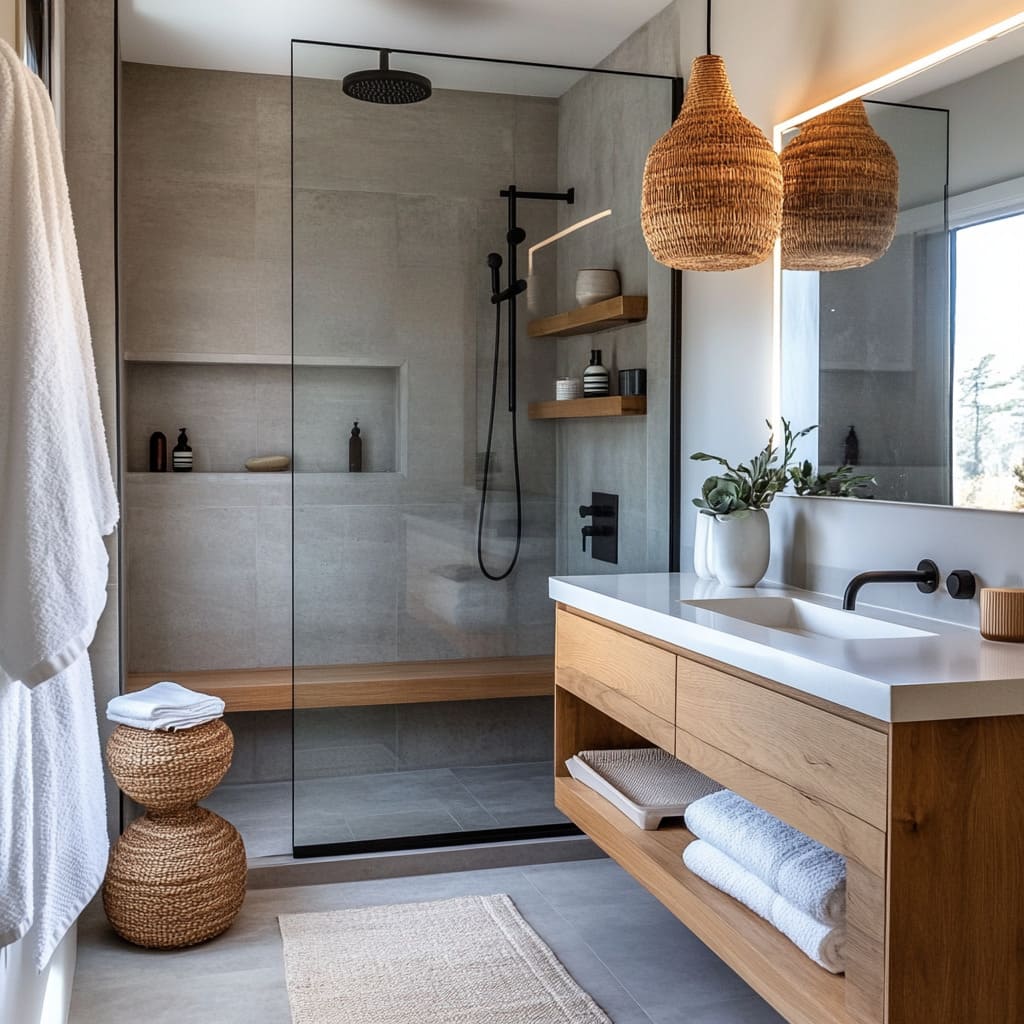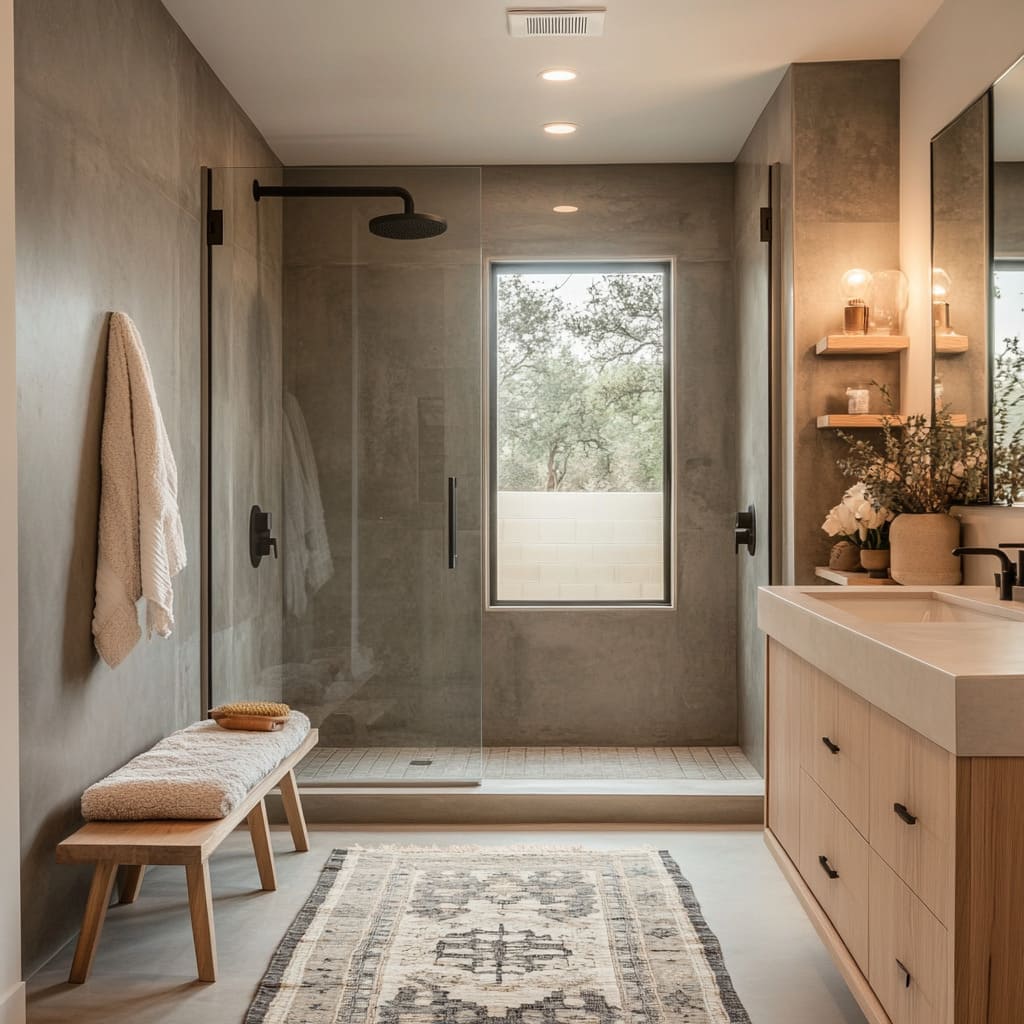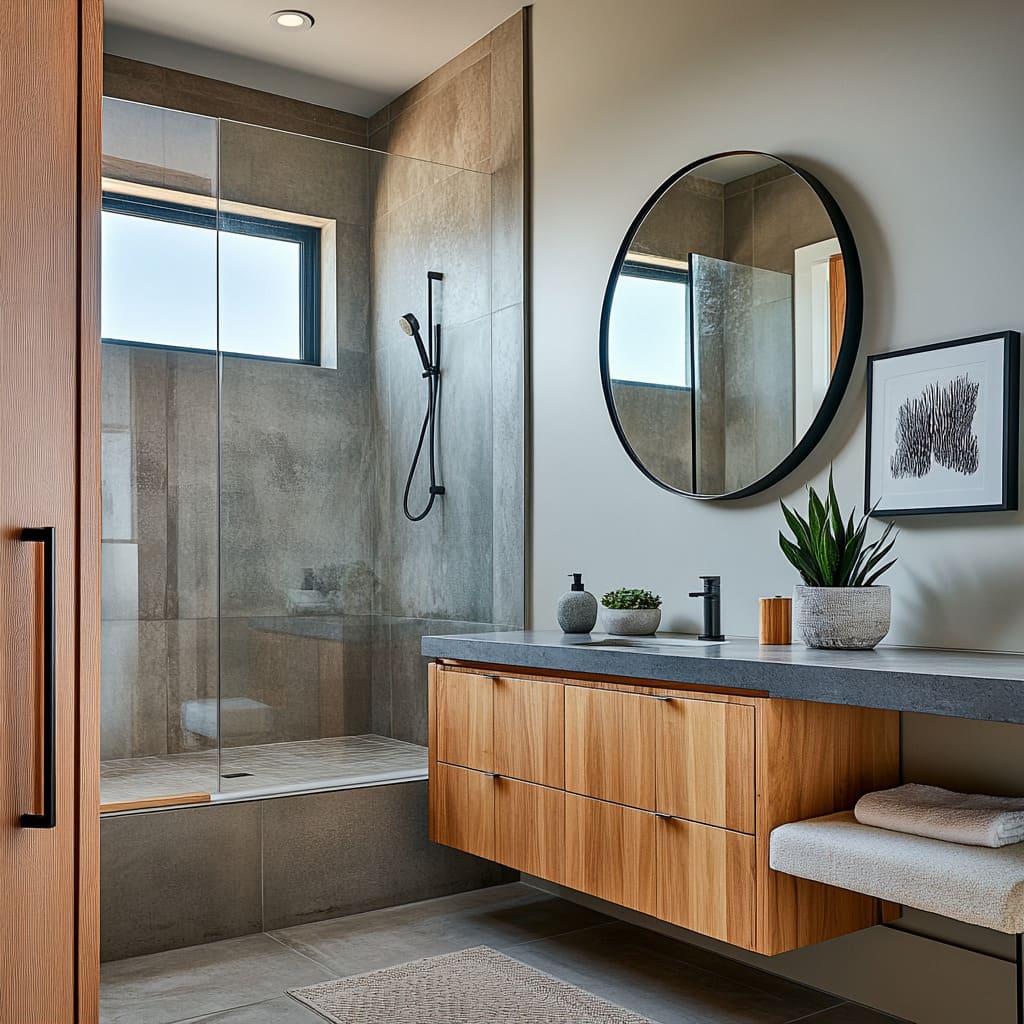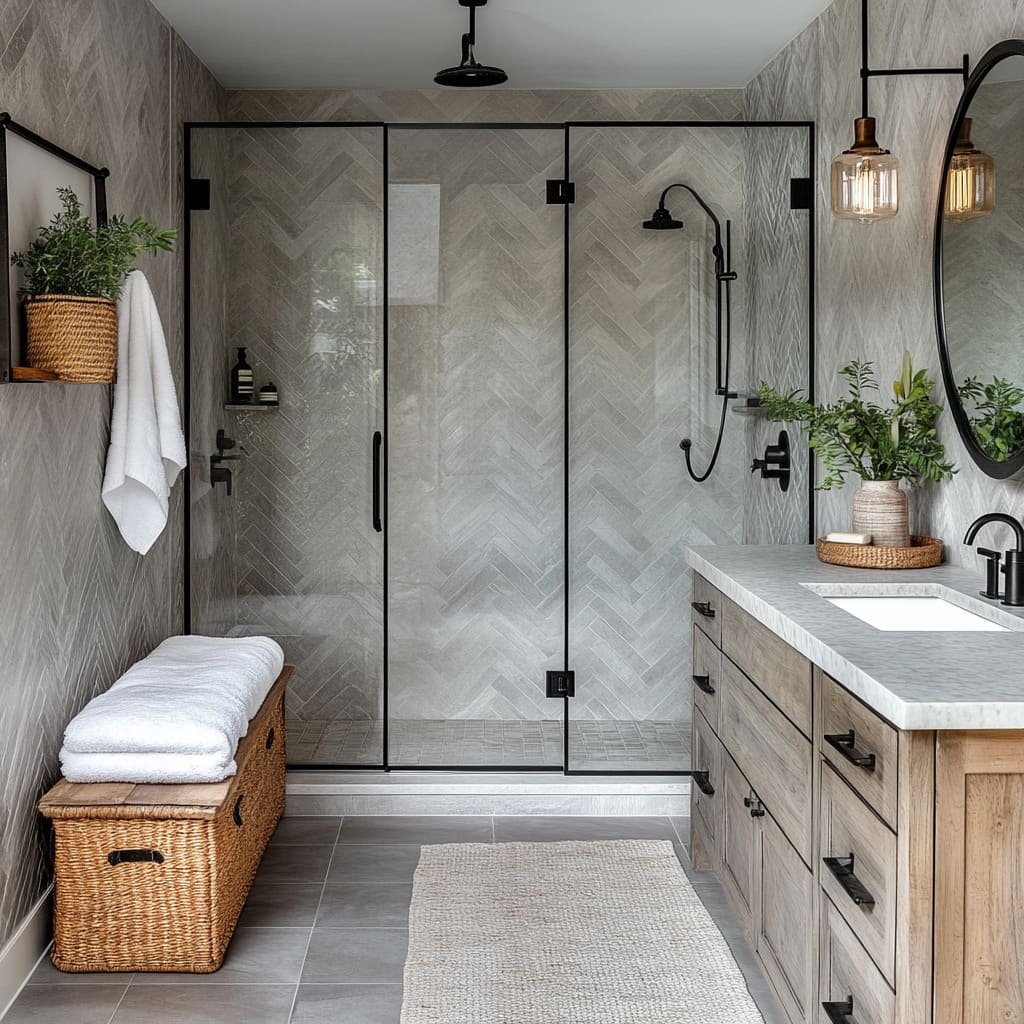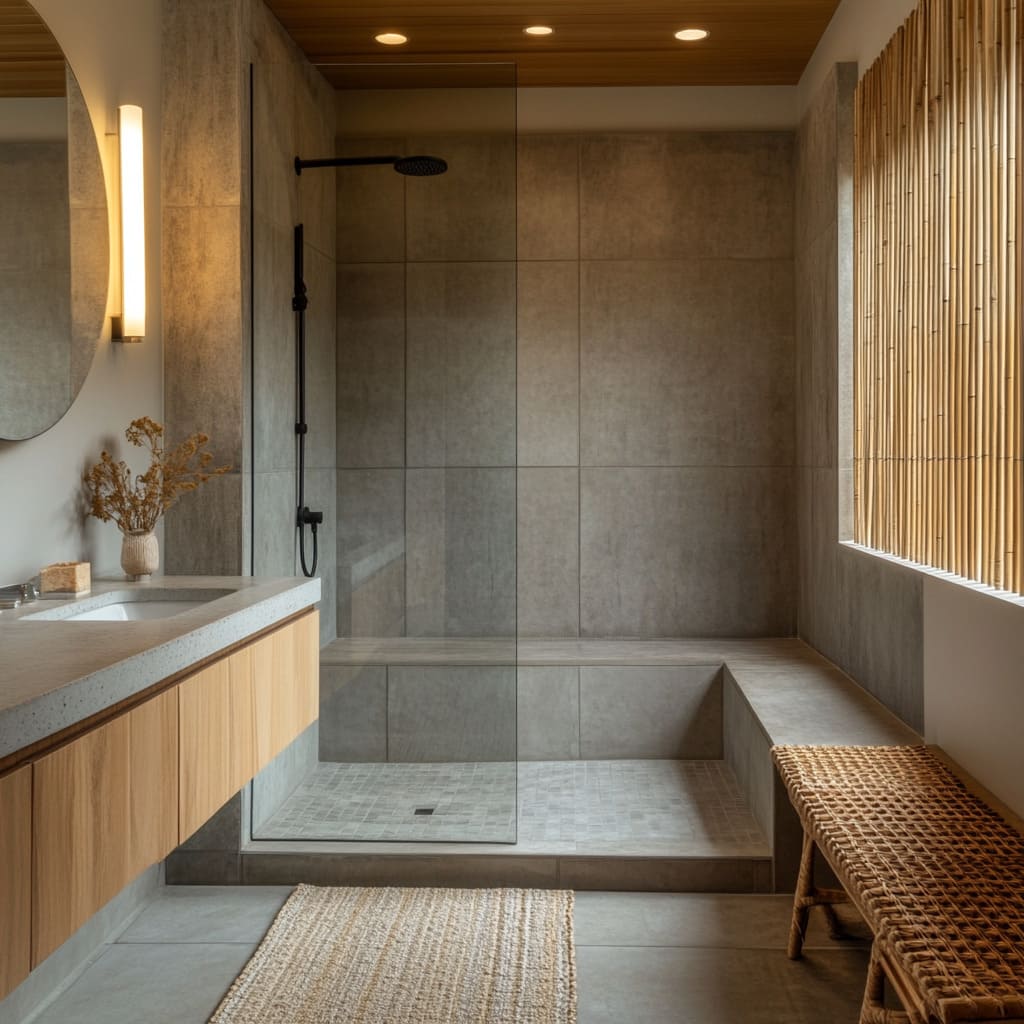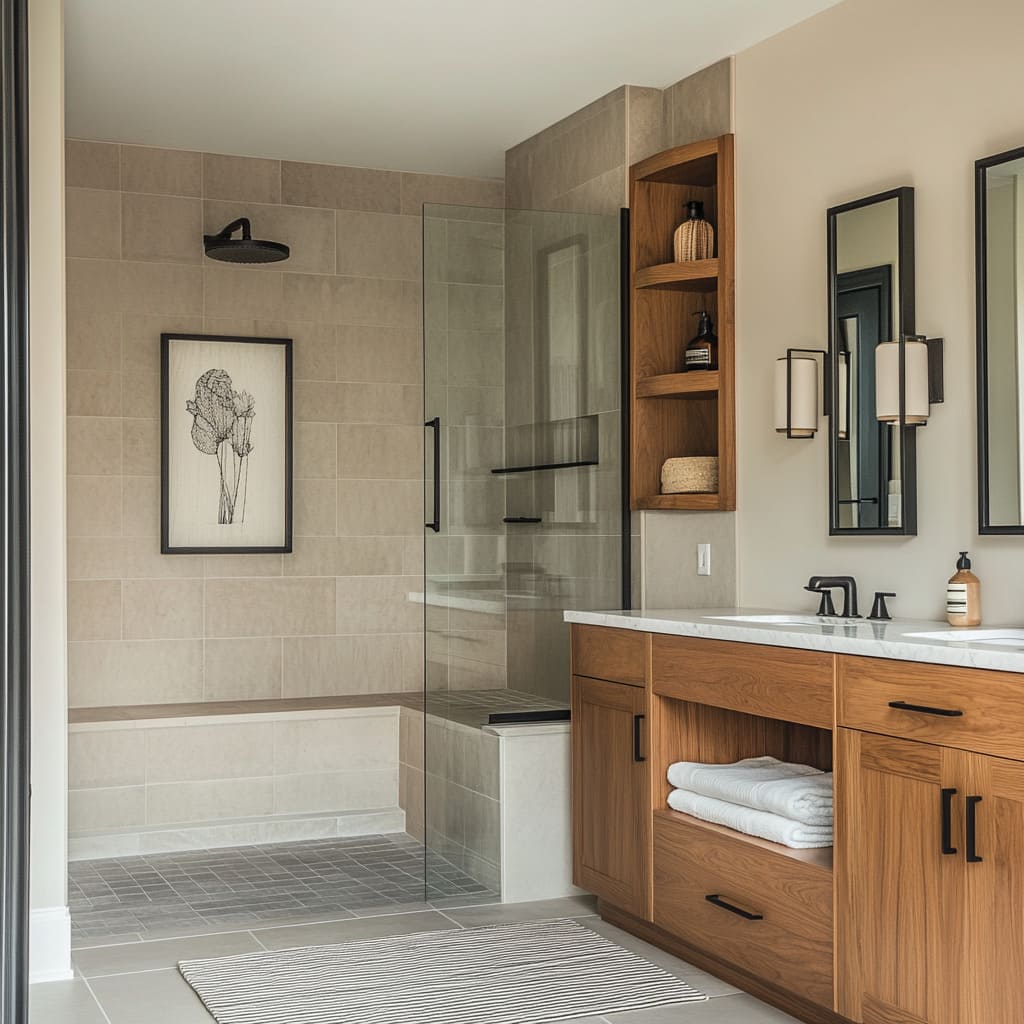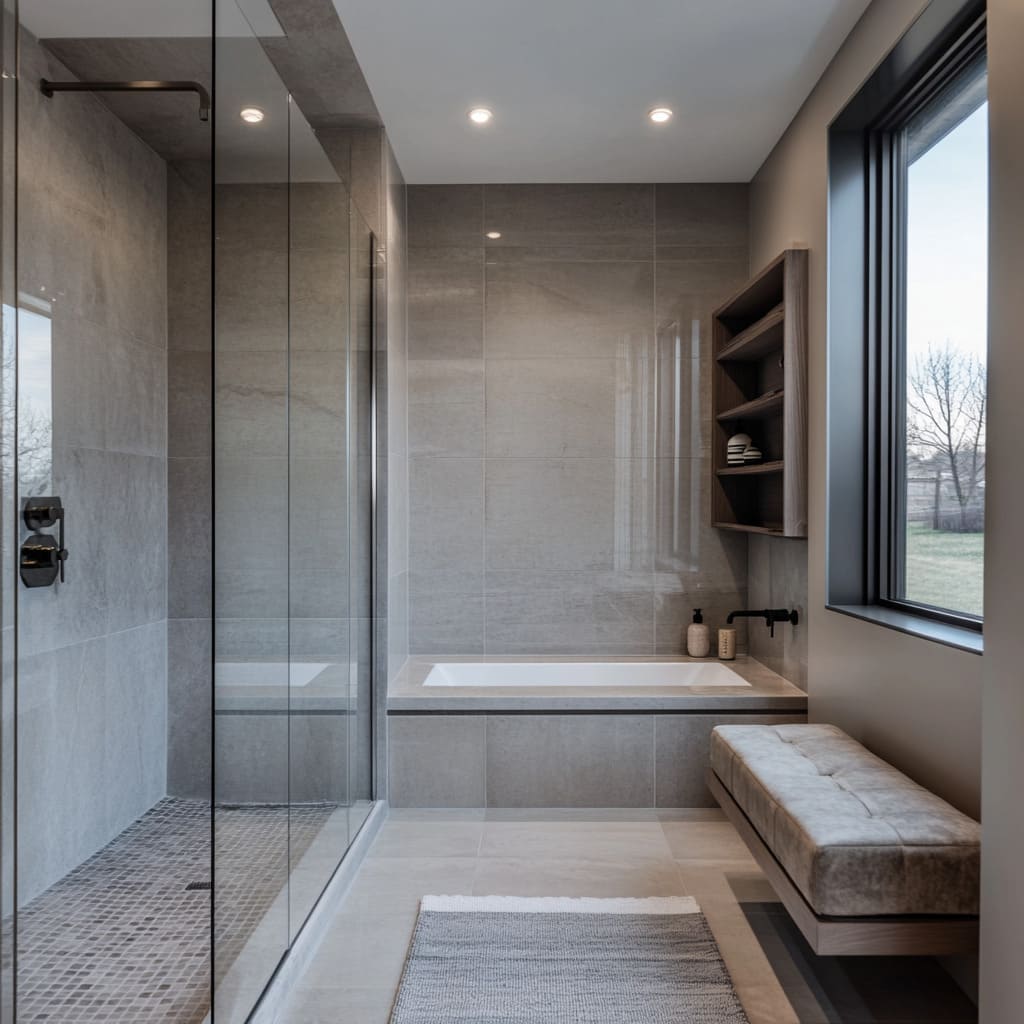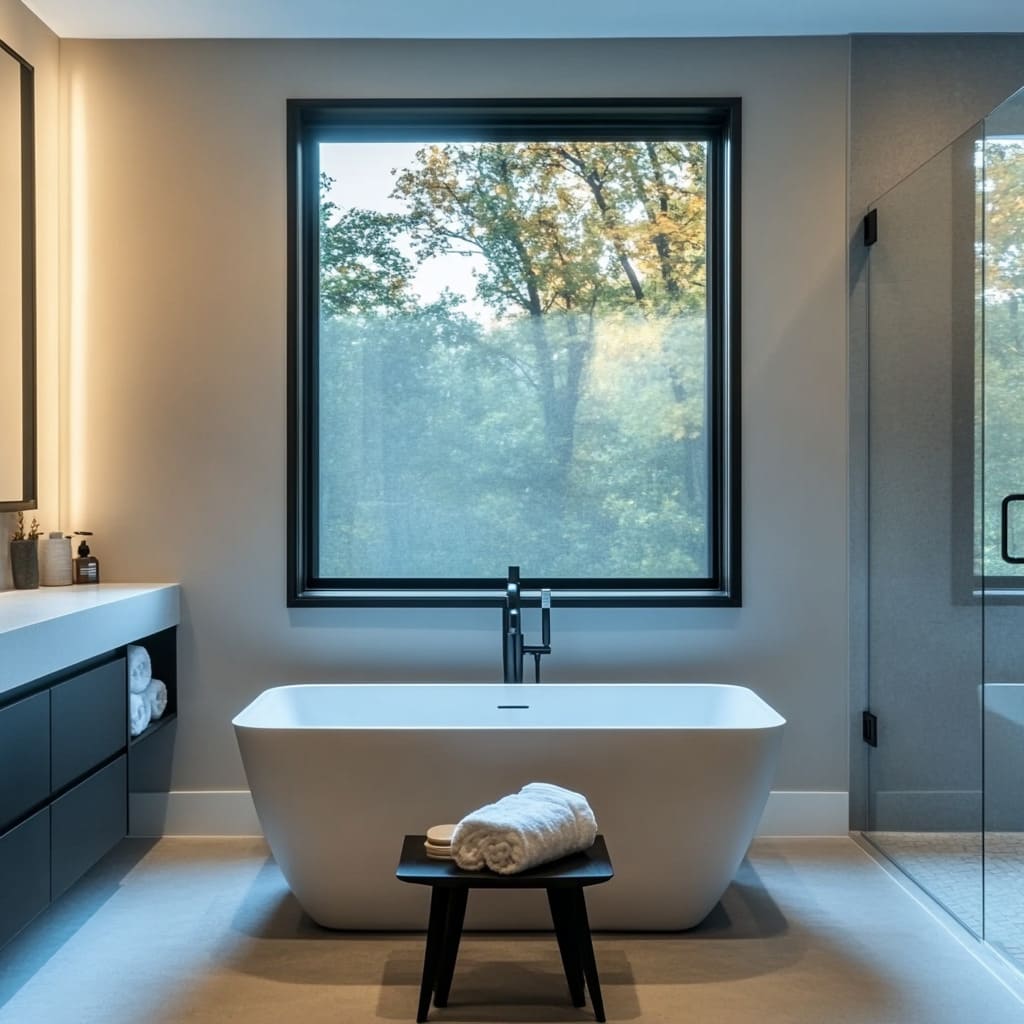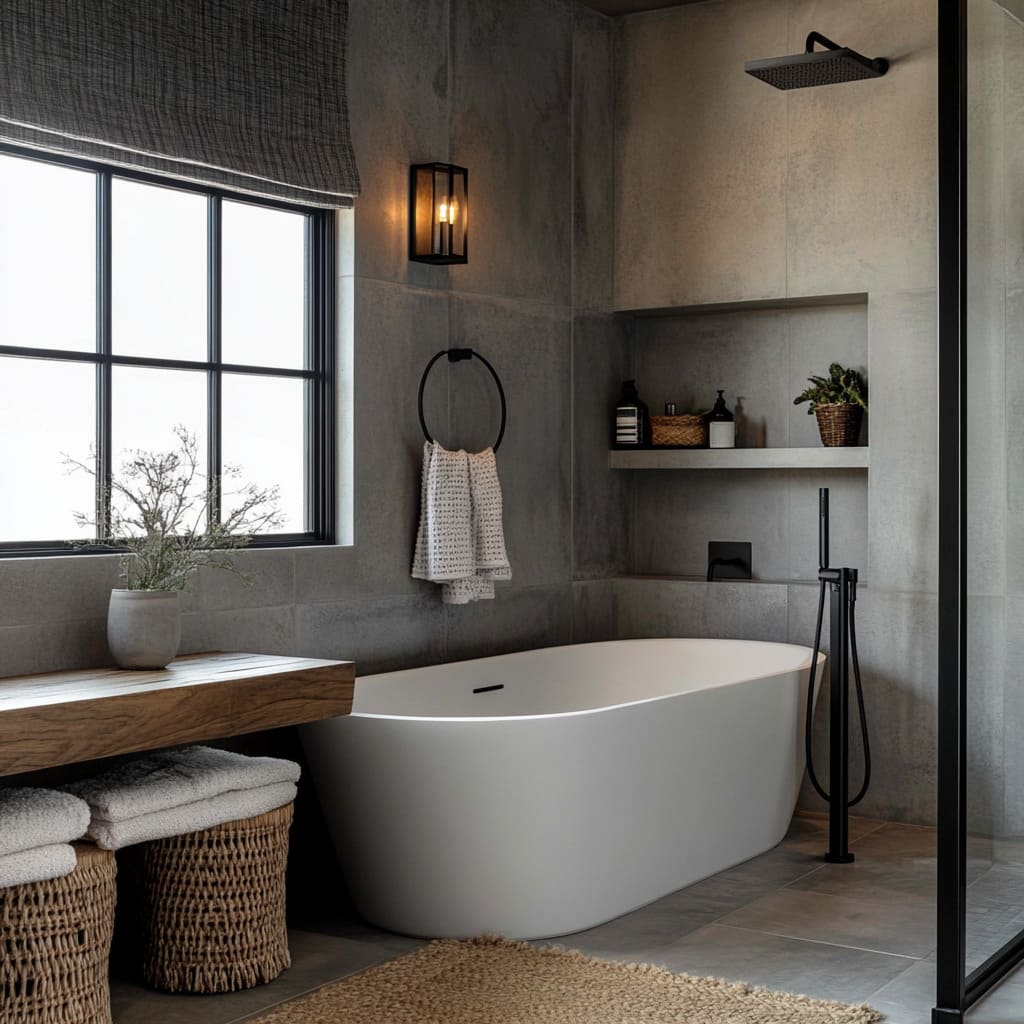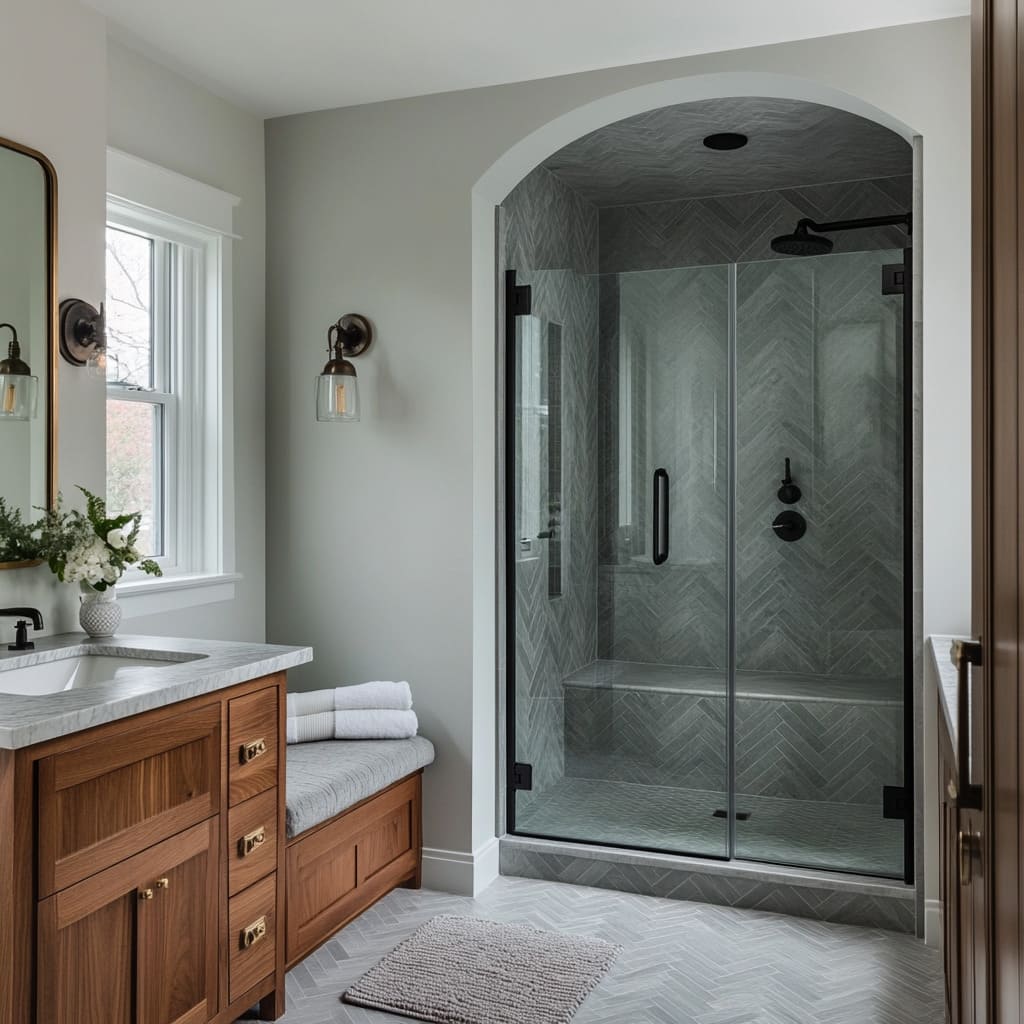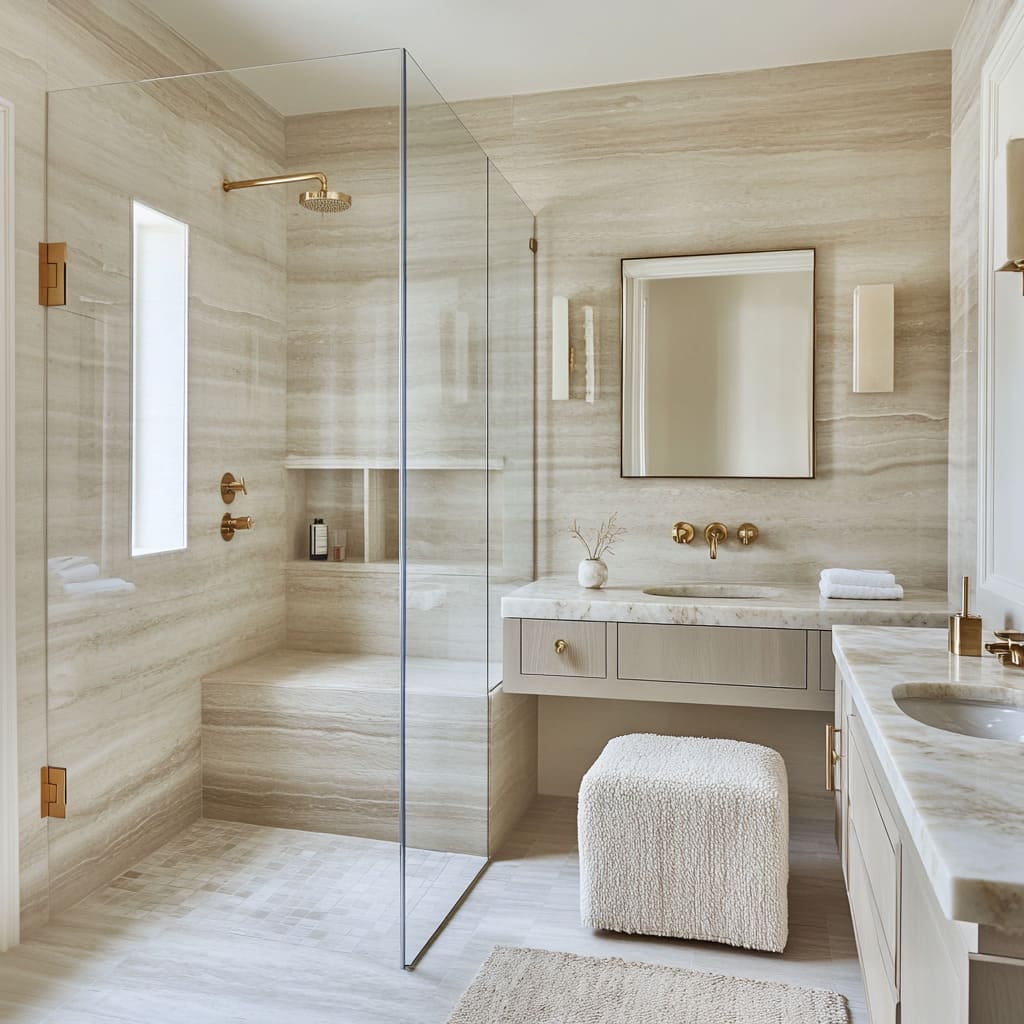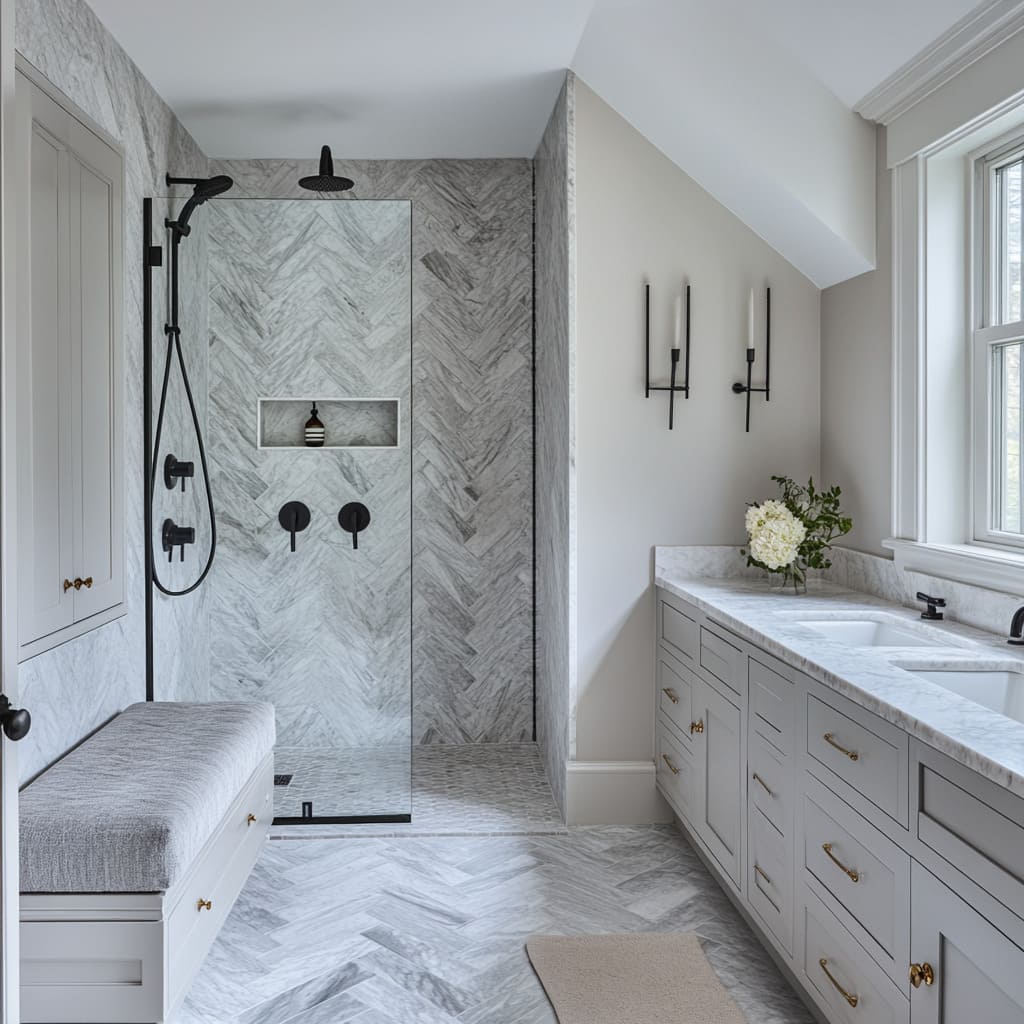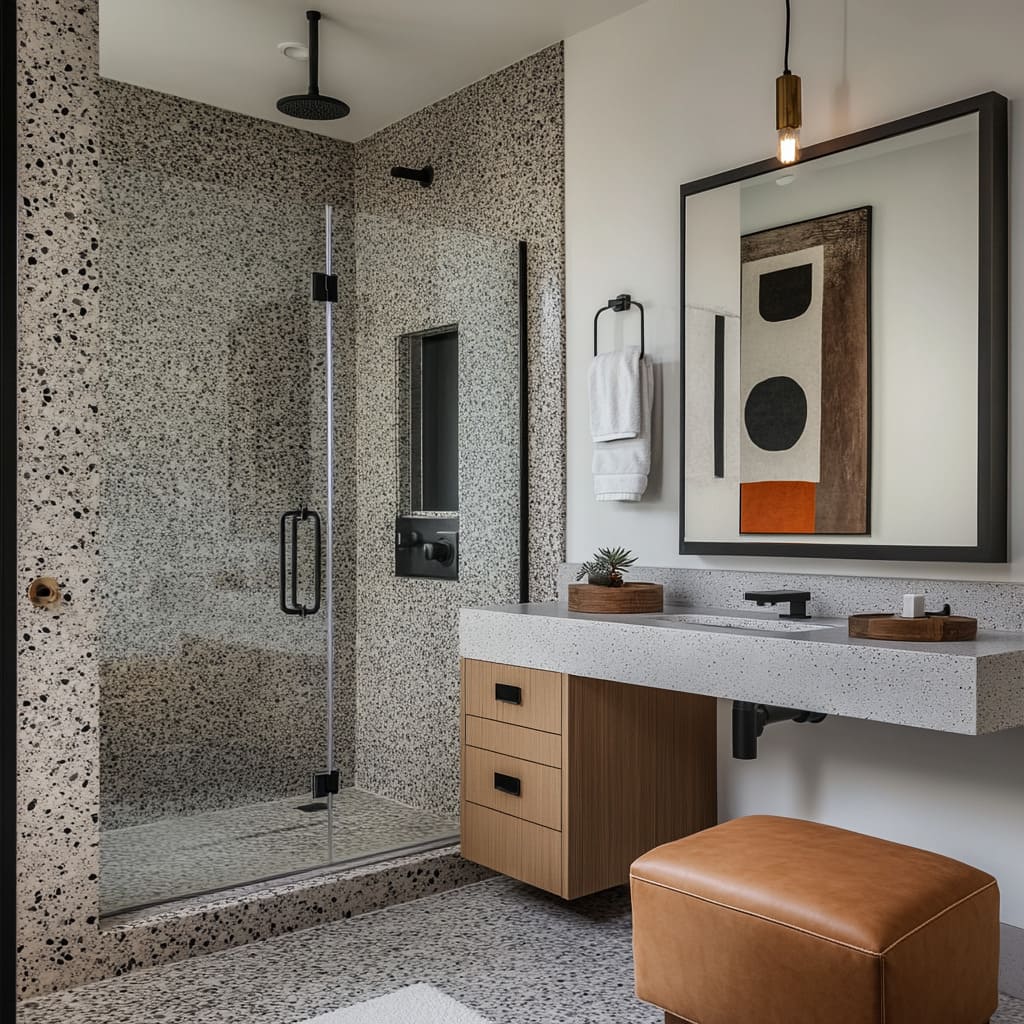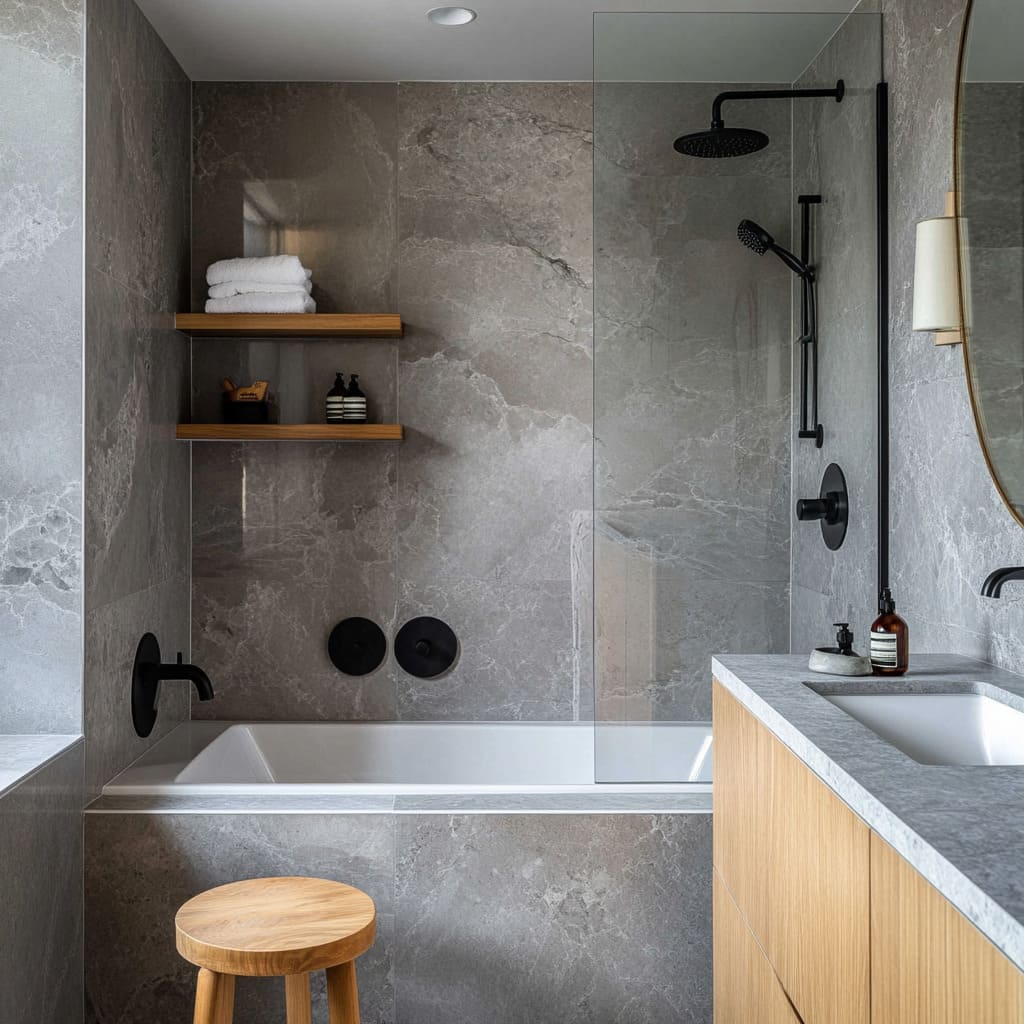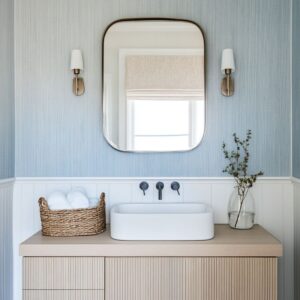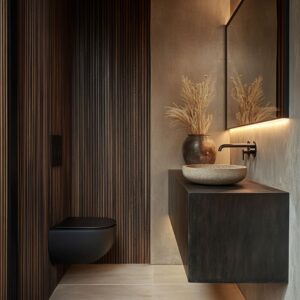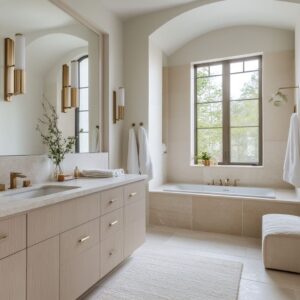Grey bathrooms have a reputation for being sleek and stylish, but there’s a lot more to them than just color choice. This article takes a deep dive into grey bathroom ideas, breaking down details that often go unnoticed and showing how they can be used effectively in a typical American home.
Whether you’re planning a full remodel or just refreshing your space, each section will explore key design elements, materials, and layout choices that can make a real difference. From tile patterns that subtly change the feel of a room to smart lighting that adds warmth, these ideas go beyond aesthetics to create bathrooms that look great and work well in everyday life.
Integration of Wood Tones to Moderate Grey
A gray tiled bathroom can sometimes feel too cool or sterile, but the right wood elements can completely change that impression. Natural wood introduces warmth and texture, making the space feel more balanced.
A light wood vanity, for example, brings a soft contrast against grey tiles, preventing the space from looking flat. Pairing it with black or brass hardware adds definition, keeping the design sharp and intentional.
Beyond vanities, other wood features can help soften a grey palette in creative ways. A wood slatted panel mounted on a concrete or tiled wall not only warms up the space visually but also improves acoustics by reducing echo—especially useful in bathrooms with high ceilings or hard surfaces.
Open wood shelving is another option that works well for storing towels and decorative pieces while keeping the space light and uncluttered.
Since bathrooms are prone to moisture, choosing the right type of wood and protective treatments is essential. Sealed oak, teak, and walnut are popular choices because they hold up well in humid conditions.
If using reclaimed wood for a more rustic look, it’s worth applying a waterproof sealant to maintain its durability over time. Whether adding a small wood bench, floating vanity, or shelving, these touches help bring balance to a grey-heavy design, creating a space that feels welcoming instead of overly cool.
Tile Patterns, Movement, and Practicality
Choosing the right tile layout can make a big difference in how a bathroom looks and functions. Flat grey surfaces can sometimes feel static, but using patterned tile arrangements introduces movement and depth, making the space more visually engaging.
Large-format matte grey tiles are a practical choice, as they minimize grout lines and help conceal water spots—ideal for keeping a bathroom looking fresh with less maintenance. For a more refined look, grey marble slabs running from the shower to the vanity create a seamless flow, giving the space a polished, high-end feel.
However, natural marble can be pricey and requires regular sealing. A smart alternative is high-quality porcelain or ceramic tiles that mimic the veining and texture of marble, offering the same aesthetic at a fraction of the cost.
Herringbone patterns are another way to bring life to a grey bathroom. Unlike standard grid layouts, herringbone adds a dynamic touch, subtly disguising minor imperfections and creating an illusion of movement.
This makes it a great option for shower walls or flooring where a little variation enhances the overall design. If you’re looking for more grey bathroom tiles ideas, consider using a combination of smooth and textured finishes to create contrast.
A mix of glossy and matte tiles, for example, can add dimension without overwhelming the space. Whether working with a minimalist layout or a bold statement wall, the right tile choice helps balance practicality with style.
Floating Elements and Their Spatial Effect
Floating elements are a simple yet effective way to make a bathroom feel open and uncluttered. Instead of bulky cabinets that take up floor space, a wall-mounted vanity keeps the room visually light, making even a compact layout feel more spacious.
This works especially well in grey bathrooms, where the color itself leans toward a sleek, modern aesthetic. When paired with soft wood tones or subtle metal finishes, a floating vanity brings in warmth without overpowering the space.
Beyond vanities, floating storage is another smart choice. Inside the shower, wooden-look shelves built into a niche offer a place to keep toiletries while maintaining a clean, streamlined appearance.
Unlike traditional corner caddies or wall-mounted racks, this approach blends storage seamlessly into the design. Open shelving near the vanity can have a similar effect, holding essentials like towels and decor without closing off the room.
One important detail to keep in mind is structural support. Floating vanities and shelves need secure wall reinforcement, especially if they’ll be holding heavy materials like stone countertops or solid wood panels.
Proper framing behind the walls ensures that these elements remain stable over time. When planned correctly, floating features create a bathroom that feels more open, balanced, and effortlessly modern.
Subtle Lighting Layers for Depth
Lighting does more than brighten a space—it shapes the entire mood of a gray bathroom. While decorative sconces and pendant lights can add character, it’s the less noticeable layers of illumination that truly make a difference.
A well-placed LED strip under a floating vanity, for instance, casts a soft glow that gives the bathroom a spa-like atmosphere. This is especially effective in spaces with darker grey tones, where indirect lighting helps prevent the room from feeling too cool or flat.
Built-in shelf lighting is another way to add warmth and depth. A soft backlight inside a recessed niche highlights decor and essentials without overwhelming the space with harsh brightness.
This technique works particularly well with textured tiles, as the gentle illumination enhances the material’s natural patterns. Similarly, integrated lighting around mirrors eliminates unflattering shadows, making daily routines like shaving or makeup application easier.
For a balanced effect, layering multiple light sources ensures that no area feels too dim or too intense. A mix of ambient lighting from ceiling fixtures, task lighting at the vanity, and accent lighting in shelving or niches creates a bathroom that feels both functional and inviting.
Even in a compact space, these subtle lighting choices make a noticeable difference, adding warmth and depth to a grey-based design.
Pairing Grey with Greenery and Natural Accents
A grey bathroom can sometimes feel a little too structured, but adding natural elements instantly softens the look. A potted plant on a vanity, a woven storage basket, or even a small wooden stool can break up the straight lines and add a bit of warmth.
These details introduce texture and contrast without overpowering the neutral color scheme. Live plants are an easy way to bring in a fresh, organic feel.
Moisture-loving varieties like ferns, pothos, and peace lilies thrive in bathroom humidity and require little maintenance. If natural light is limited, snake plants or ZZ plants can handle low-light conditions while still adding that lush touch.
Even dried botanicals in a simple vase can create a calming focal point.
Beyond plants, natural fiber accents like jute rugs or rattan baskets add another layer of warmth. However, since bathrooms deal with constant moisture, it’s best to choose pieces that are treated to resist mildew.
Bamboo bath mats are a great alternative to fabric ones, as they dry quickly and blend well with both modern and rustic grey designs. Whether used in small doses or as statement decor, natural elements bring balance to grey tones, making the bathroom feel more inviting and relaxed.
Variations in Surface Texture
The way a surface feels has just as much impact as its color. A grey bathroom with polished stone tiles gives off a sleek, high-end look, while a textured plaster finish brings a more natural, organic feel.
This is especially important in smaller bathrooms, where different textures can help create depth and dimension without adding clutter. For a soft, handcrafted touch, a plaster-like finish such as tadelakt adds warmth and a subtle variation in tone, making the space feel less rigid.
On the other hand, large-format dark grey tiles with a polished surface reflect light, creating a clean, modern aesthetic often found in urban-inspired designs. In a small grey bathroom, combining matte and glossy finishes can prevent the space from feeling too flat.
Textured tiles, such as stucco-like surfaces or patterned relief designs, also serve a practical purpose. They help disguise minor water spots and everyday wear, making them ideal for high-traffic areas like showers or vanity backsplashes.
However, some textured surfaces require extra maintenance, especially those that need regular sealing to prevent moisture absorption. Homeowners looking for a balance between style and practicality should consider the level of upkeep needed before choosing a finish.
With the right mix of textures, even a compact grey bathroom can feel dynamic and layered rather than monotonous.
Details that Enhance Practical Use
The best bathroom designs don’t just look good—they make daily routines easier. A thoughtful approach to storage and seating can help a bathroom feel more organized while adding a touch of comfort.
Built-in solutions, like a shower bench or a recessed shelf, keep everything within reach without cluttering the space. A built-in bench with soft upholstery can turn part of the bathroom into a dressing area, making it feel more like a personal retreat rather than just a functional space.
Maximizing space is especially important in grey bathroom themes, where clean lines and a balanced layout are key to maintaining a polished look. A floating vanity with a towel shelf underneath keeps essentials accessible while freeing up wall space.
This approach not only improves storage but also makes the room feel more open—especially in smaller layouts.
Shower designs can also incorporate hidden features that improve usability without interrupting the visual flow. A well-placed shower bench serves both as seating and extra storage, offering a spot for bath products without needing bulky corner racks.
If positioned beneath a small window, it allows natural light to filter in while maintaining privacy—ideal for brightening up a grey-toned space without artificial lighting. These small but intentional details help blend style with function, making the bathroom feel as practical as it is visually appealing.
Coordinating Metal Finishes and Hardware
Choosing the right metal finishes plays a bigger role than many realize in setting the tone of a grey bathroom. While the color itself provides a neutral foundation, fixtures and hardware determine whether the space leans warm, cool, or bold.
Gold handles on pale grey cabinetry bring a polished contrast, adding just enough brightness without overpowering the space. Brass fixtures work particularly well with mid-toned greys, softening any coolness and adding a timeless quality.
For those aiming for a more contemporary feel, matte black is a strong choice. It sharpens the contrast in grey modern small bathroom designs, giving the space a clean, streamlined look.
A practical advantage is that black hardware tends to mask fingerprints better than polished metals, but it may require more frequent wiping to prevent visible water spots. In compact bathrooms, keeping all metal elements—faucets, drawer pulls, shower frames, and towel bars—within the same finish helps maintain a cohesive appearance, preventing the room from feeling visually cluttered.
Mixing metals can work when done intentionally, but balance is key. A common approach is to use one dominant metal for major fixtures like faucets and showerheads, while a second finish appears in smaller details such as lighting or cabinet hardware.
This prevents the space from feeling too uniform while still keeping the overall design harmonious. Whether warm or cool, bold or understated, the right metal choices can completely shift the mood of a grey bathroom without requiring major renovations.
Layout Innovations Suited to Varied Ceilings and Angles
Bathrooms with sloped ceilings or irregular layouts often present design challenges, but the right approach can turn these limitations into advantages. Instead of fighting against angles, working with them through smart tile choices and storage solutions creates a visually balanced and highly functional space.
In an attic bathroom, for instance, the shower placement needs careful planning to ensure comfortable standing height, often requiring a handheld showerhead instead of a traditional overhead fixture.
One way to make the most of an unconventional layout is by using small-format tiles such as micro-mosaics. Unlike large tiles that require extensive cutting to fit into tight corners, smaller tiles naturally adapt to sloped walls and curved areas with minimal disruption.
This technique is particularly useful for creating a seamless look in compact spaces where every inch counts. In small bathroom ideas in grey, using these types of tiles on both walls and floors can enhance continuity, making the space feel more open despite its size.
Maximizing storage in awkward nooks is another game-changer. Instead of leaving unusable corners empty, built-in ledges or recessed shelving can transform them into practical storage zones for towels, toiletries, or decorative accents.
Floating vanities or wall-mounted shelves also help preserve floor space, preventing the room from feeling cramped. By embracing rather than working against unique architectural elements, these design choices turn tricky layouts into spaces that feel intentional and well-planned.
Conclusion
These examples show that grey bathrooms don’t have to feel repetitive or lacking in character. The secret to a space that remains inviting over time is in the mix of elements—balancing textures, introducing warm wood, using subtle lighting, and adding greenery to soften the look.
Whether the approach leans toward classic marble, industrial concrete, or a modern floating vanity, grey proves to be a flexible base that adapts to different styles.
What truly sets apart a well-thought-out bathroom is attention to the details that often go unnoticed. The way tiles are arranged can add movement and disguise wear, under-vanity lighting makes a space feel more open, and the right wood treatments ensure long-term durability.
Even hardware choices influence the overall feel, with brass warming up a cooler palette and matte black keeping the look crisp and modern.
By studying these variations and applying the right mix of visual and practical elements, any homeowner can create a grey bathroom that is both stylish and suited to everyday life. The key is to think beyond the color itself and focus on how each material and design choice contributes to a space that feels cohesive, comfortable, and easy to maintain.

